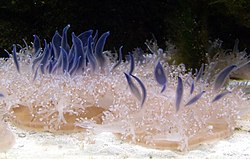| Revision as of 03:43, 4 June 2009 editAndrewRT (talk | contribs)Autopatrolled, Extended confirmed users, Pending changes reviewers9,839 editsm Quick-adding category Scyphozoa (using HotCat)← Previous edit | Revision as of 03:43, 4 June 2009 edit undoAndrewRT (talk | contribs)Autopatrolled, Extended confirmed users, Pending changes reviewers9,839 editsm Removed category Animals (using HotCat)Next edit → | ||
| Line 50: | Line 50: | ||
| ] | |||
| ] | ] | ||
Revision as of 03:43, 4 June 2009
| Cassiopea andromeda | |
|---|---|

| |
| Scientific classification | |
| Kingdom: | Animalia |
| Phylum: | Cnidaria |
| Class: | Scyphozoa |
| Order: | Rhizostomae |
| Family: | Cassiopeidae |
| Genus: | Cassiopea |
| Species: | C. andromeda |
| Binomial name | |
| Cassiopea andromeda Forskål, 1775 | |
Cassiopea andromeda (Upside-Down Jellyfish) is a type of jellyfish that usually lives in intertidal sand or mud flats, shallow lagoons, and around mangroves. This jellyfish, many times mistaken as sea anemones, usually has its mouth upward on the bottom. Its bell, which is yellow-brown with streaks and spots that are white or pale, vibrates to make the water flow through its arms for respiration and the obtaining of food.
Alimentation and stragedies
Cassiopea andromeda is carnivorous and eats small animals from the sea or just pieces of them after it paralyzes its prey with its mucous and nematocysts when they are released. This jellyfish also lives in a symbiotic relationship with photosynthetic dinoflagellate algae, the Zooxanthellae, and with shrimps. The Zooxanthellae live in the tissues of the ventral surface of its body and it is the responsible for the color of it. As the Zooxanthellaeon gets food for the Cassiopea andromeda, in response, it gets the sunlight that is necessary for the photosynthetic dinoflagellate algae. Therefore, the shrimp has a different symbiotic relationship with this jellyfish. It lives in its tentacles and protects it by taking the parasites off. In exchange, the Cassiopea andromeda mainly offers protection to the shrimp from the environment.
Reproduction
As a cnidarian, this jellyfish has an asexual and sexual reproduction. It reproduces by budding when it is in a polyp form. When it is in a medusa form, it reproduces sexually. The medusa female produces the eggs and keep them. As the male produces the sperm and releases them in the water, the female uses its tentacles to bring the sperm to fertilize its eggs.
Size
This jellyfish can measure the maximum of 30.0 cm wide.
Effects to humans
The Cassiopea andromeda does not have many effects to human life. Its is really beautiful and because of that, it brings people to norkeling or diving to see the wonders of the sea, and with that, the tourism and the economy of the locality are expended. However, if you are thinking about visiting one of this jellyfish, you should take care because as they have tinging cells or nematocysts, if you get stung, it may cause skin welts, skin rash, itching, vomiting and skeletal pains.
Taxonomy
Domain: Eukaryota
- Kingdom: Animalia
- Phylum: Cnidaria
- Class: Scyphozoa
- Order: Rhizostomeae
- Family: Cassiopeidae
- Genus: Cassiopea
- Scientific name: Cassiopea andromeda
- Genus: Cassiopea
- Family: Cassiopeidae
- Order: Rhizostomeae
- Class: Scyphozoa
- Phylum: Cnidaria
External links
Category: